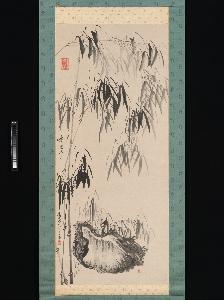Gion Nankai
Yoichiro;Gion Nankai
Mjesto: Kii (Wakayama Prefecture)
Rođen: 1677
Smrt: 1751
Biografija:
Early Life and Education
Gion Nankai, originally Gion Yu, was a Japanese Confucianist, author, and painter in the nanga style. Born in 1677 in Edo (present-day Tokyo), he was the eldest son of Gion Jun’an, a doctor who served the Kishū Domain of the Tokugawa clan.
Artistic Career
At the age of thirteen, Gion Nankai began to receive instruction from the Confucianist Kinoshita Jun'an and became attached to the group of ten disciples that included Arai Hakuseki and Muro Kyūsō. He established himself as a teacher of Confucianism in 1713, but was expelled from his teaching position for misconduct at the age of twenty-four.
Notable Works
- Window onto Bamboo on a Rainy Day, a painting showcasing the movement's focus on nature and use of empty space to convey a sense of tranquility, is one of his most notable works. (View Painting on Wikioo.org)
- Gion Nankai's study of the art of the Yuan and Ming dynasties, as well as his incorporation of elements from them into his works, demonstrates his unique style.
- His collection of essays on Chinese poetry is another example of his literary talent.
Influence and Legacy
As one of the pioneers of nanga (literati painting), Gion Nankai passed it along to his students, including Yanagisawa Kien and Ike no Taiga. His influence can be seen in many modern Japanese artists and styles.
Museums and Collections
Many of Gion Nankai's works are in the Tokyo National Museum, showcasing his significant contribution to Japanese art history. Key Points: * Born in 1677 in Edo (present-day Tokyo) * Confucianist, author, and painter in the nanga style * Influenced by Chinese literati painting and calligraphy * Notable works include "Window onto Bamboo on a Rainy Day" and essays on Chinese poetry * Legacy can be seen in many modern Japanese artists and styles The Nanga Art Movement (on Wikioo.org) provides more information on the context and influence of Gion Nankai's work.

